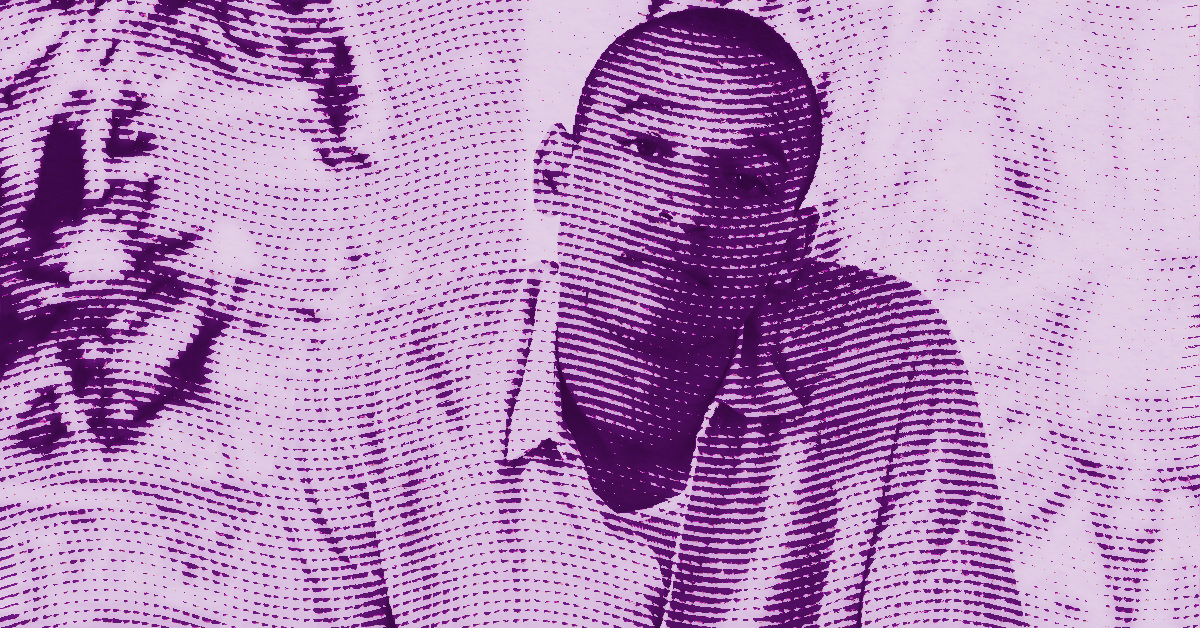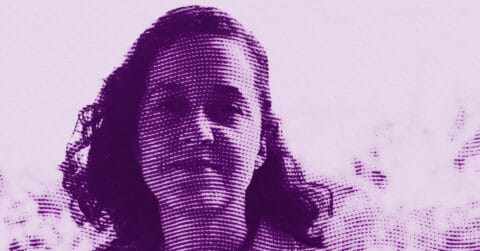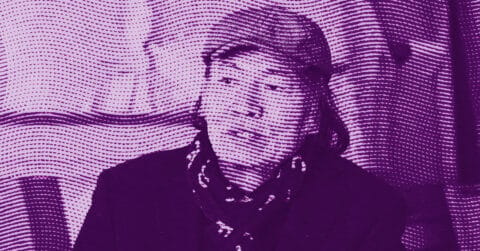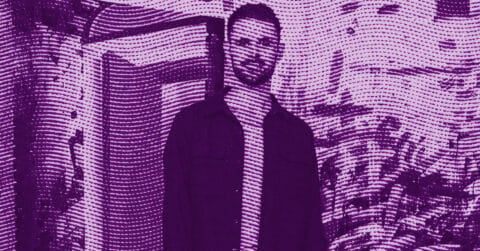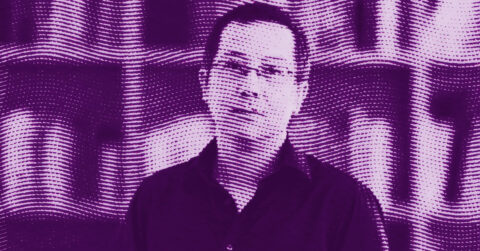Listen to me carefully, you bunch of snobs: if you still believe that contemporary painting is just about white canvases sold at sky-high prices in international art fairs, Chase Hall is here to remind you that some artists still dare to ask real questions. This 32-year-old self-taught American painter has been building a singular body of work for a decade that questions mixed-race identity, self-construction, and the representation of Blackness in an America that still struggles to confront its own contradictions. Armed with Ethiopian coffee and raw cotton canvas, Hall develops a visual language that refuses the ease of racial pathos while fully assuming the historical violence inscribed in his very materials.
Born in Saint Paul, Minnesota, to a white mother and a Black father, Hall grew up in constant instability, changing schools eight times before he was sixteen. This nomadic childhood, swinging between disadvantaged neighborhoods and affluent areas, between Chicago, Las Vegas, Colorado, Dubai, and Los Angeles, shaped in him a keen awareness of the class and race mechanisms that structure American society. When he arrived in New York in 2013 with the ambition of becoming a photojournalist, he had no idea that painting would become his medium of choice. But an encounter in front of a Henry Taylor canvas at the MoMA moved him to tears. This moment of aesthetic revelation made him understand that pictorial art could be a survival tool, not just bourgeois ornamentation.
Double consciousness as a conceptual foundation
To grasp the intellectual architecture underlying Hall’s work, one must return to a foundational text of African-American thought. In 1903, W.E.B. Du Bois published The Souls of Black Folk, a work in which he conceptualizes “double consciousness”: this sensation of always being watched through others’ eyes, of “measuring one’s soul by the yardstick of a world that looks on in amused contempt and pitying disdain” [1]. Du Bois writes that the African American “always feels this twoness: an American, a Negro; two souls, two thoughts, two unreconcilable strivings; two warring ideals in one dark body” [1]. This theorization of racialized subjectivity is not a mere psychological description but a profound sociological analysis of what it means to exist behind what Du Bois calls the “veil,” that symbolic barrier separating Black Americans from the full recognition of their humanity.
Hall, as a mixed-race man, experiences a particularly complex version of this double consciousness. He expressed it bluntly: “You are always ostracized because you are not one hundred percent white, and you are always vilified without receiving the full love that would come from being completely Black, without a colonial genetic history.” This interstitial position, which he describes as “hybridity,” “duality,” even “palindromic,” places him in an in-between that American society traditionally refuses to acknowledge. Historical rules such as the “one-drop rule” (which defines anyone with an African ancestor as black) or the “three-fifths compromise” (which counted one slave as three-fifths of a person) have always operated on the principle of absolute whiteness: if you are not completely white, then you are black. Hall rejects this impoverishing binary.
His artistic practice then becomes the site of a visual investigation of this “duality.” The use of brown coffee on white cotton canvas is not a mere aesthetic choice: it is a literal materialization of double consciousness. Coffee, primarily cultivated in Africa and Latin America, carries within it the history of colonial exploitation and the triangular trade. Cotton, harvested by slaves in the American South, remains one of the most powerful symbols of the slave economy. By intentionally leaving areas of blank canvas, faces without features, white knees, and unpainted genitals, Hall creates what he calls “points of refusal.” These negative spaces are not absences but insistent presences of whiteness at the very heart of the representation of blackness. This is Du Bois’s veil, made tangible.
But Hall goes further than merely illustrating W.E.B. Du Bois’s theory. Where Du Bois described the experience of African Americans whose blackness was undisputed in the eyes of white society, Hall interrogates an even more troubled condition: that of the mixed-race individual, perceived as “the black boy” by his white friends and as “the lightened boy” by his black family. This constant oscillation between two worlds that each partially reject him makes him, to use his words, a “palindromic” being, readable in both directions but never fully integrated into either. His characters, often depicted in activities historically coded as white, such as horseback riding, surfing, tennis, are figures who refuse to be confined to “stereotypical black spaces.” Hall paints black men at rest, black surfers on the beaches of Malibu, black riders in equestrian attire, because he wants to complicate the gaze cast on blackness and dismantle the monolith.
This approach directly echoes Du Bois’s concerns about what he called the “Talented Tenth,” the ten percent of black men who, through education and civic engagement, were meant to show the world the full intellectual and cultural capacity of their people. Hall actually created a work titled The Talented Tenth (Mixed Doubles) (2025), where four black men in tennis attire stand in front of a brick wall, rackets in hand. The title works on several levels: it refers to Du Bois’s 1903 text, but also to the “mixed doubles” in tennis, and of course to the “mixed” identity that Hall claims. The figures wear clothes inspired by classic American fashion: tennis sweaters, cardigans, and pleated trousers, and display hairstyles and features sometimes rendered in negative space, those “points of refusal” characteristic of his visual language. The piece simultaneously functions as a historical document and a futuristic daydream, as memory and projection.
Double consciousness becomes, for Hall, a multiple, layered consciousness. It is no longer just about navigating between two fixed identities, but about recognizing that identity itself is a fluid process, a permanent becoming. As he says: “being and becoming at the same time.” His paintings are “receipts of this becoming,” traces of an obsessive questioning: who am I when no one is looking? Who am I when everyone is looking? How can I exist outside the boxes that society has prepared for me? These questions, Du Bois posed over a century ago. Hall reformulates them for our time, where mixed heritage is widespread but mental structures inherited from segregation persist with disconcerting tenacity.
Gordon Parks and the legacy of the documentary gaze
To understand Hall’s formal and political ambition, it is essential to summon the figure of Gordon Parks, a pioneer of African American photojournalism. Born in 1912 in Kansas, Parks was the first African American photographer hired by Life magazine in 1948. For more than two decades, he documented the civil rights movement, urban poverty, Harlem gang life, and also became the first black director to helm a major Hollywood film with The Learning Tree (1969), an adaptation of his semi-autobiographical novel. Parks declared: “I understood that the camera could be a weapon against poverty, against racism, against all kinds of social injustices” [2].
When Hall arrived in New York with his camera, he explicitly referred to Parks. He wanted to do photojournalism in Parks’s manner, that is, with empathy, dignity, and engagement. For years, he walked the city from fifteen to twenty-five kilometers a day, photographing faces, situations, moments of life. This training of the eye through walking and observation, which Parks also practiced by spending weeks with his subjects, deeply shapes his sensibility. When Hall began to paint, it was not an abandonment of photography but an extension of it by other means. The framing, composition, the attention paid to clothing as social and identity marker, all come from his photographic training.
Parks had the principle of saturating his gaze with his subject before taking a single image. Hall proceeds similarly: his paintings are never hasty illustrations, but condensations of accumulated memories, observations, and reflections. The characters he paints, jazz musicians, Tuskegee aviators, workers in overalls, and American football players, all have the quality of being both archetypes and unique individuals. The same approach is found in Parks: his subjects, whether Red Jackson, a young gang leader from Harlem, or Flavio da Silva, an asthmatic child from the favelas of Rio, are always treated with a humanity that refuses sensationalism.
Parks’ lesson is twofold. On one hand, to show that documentary art can be a tool for social justice. On the other, to demonstrate that a Black artist can master all mediums, photography, literature, cinema, and music, without needing the validation of academic institutions. Parks, like Hall, is self-taught. This self-teaching is not a handicap but an asset: it allows escaping rigid formatting and ossifying conventions, and it creates a truly personal language.
Hall has integrated from Parks the taste for clothing as a revealer of character. His characters wear carefully chosen outfits: wide utilitarian pants from the 1940s, classic cardigans, impeccable white shirts, and yellow ties. “I dress them like I dress myself,” he confides. This identification between the painter and his subjects is never narcissistic, but a form of radical honesty: Hall paints what he knows, what he has lived, the worlds between which he has oscillated. Clothes become an identity armor, a way to signify belonging to an elective community rather than an assigned one.
The link between Hall and Parks goes beyond simple stylistic influence. It is part of a political lineage. Parks said that the camera was a weapon. Hall, on the other hand, asserts that cotton canvas and coffee are materials charged with historical violence that must be turned around. By literally using the products of colonial and slave exploitation to depict Black figures in postures of dignity, leisure, and contemplation, he accomplishes a gesture of symbolic reappropriation. It is no longer violence that defines these bodies, but grace, style, and intelligence. Just as Parks refused to reduce his subjects to their misery, Hall refuses to reduce Blackness to its suffering.
Parks also paved the way by becoming a filmmaker. His film The Learning Tree, shot in his hometown of Fort Scott, told of his childhood in segregated Kansas. Hall, meanwhile, constructs a body of work that functions like a diffracted autobiography. Each painting is a reconstructed memory fragment, a materialized moment of introspection. The titles of his works, Mama Tried (2025), Momma’s Baby, Daddy’s Maybe (title of his exhibition in Vienna in 2025), Heavy Is The Head That Wears The Cotton (2025), testify to a desire to tell personal stories that resonate universally. Parks filmed his own childhood; Hall paints his in fragments, allusions, visual encryptions.
Parks’ legacy also manifests in the attention paid to moments of calm. Parks photographed children playing in the streets of Harlem, families gathered around a table, moments of tenderness stolen from the harshness of the world. Hall paints surfers, riders, and men resting in diners. “Not everything has to be performance,” he says. This insistence on non-performance, on being rather than doing, on presence rather than struggle, constitutes a form of aesthetic resistance. In a society that only recognizes Black bodies in hyperphysicality, sports, dance, or violence, showing Black men simply existing, thinking, dreaming, is a profoundly subversive act.
A practice between materiality and metaphor
Hall’s technique is particularly interesting. He prepares up to a hundred espressos for a single canvas, varying the roasts and water-coffee ratios to obtain twenty-six different shades of brown. This coffee, still hot, is poured directly onto the raw cotton canvas. Hall must work quickly, sometimes on his knees or on scaffolding, to control the flows, stains, and nuances. It is a physical, almost choreographic process that turns the studio into a “cauldron of confrontation,” in his own words. Acrylic paint then intervenes to add touches of bright color, azure blue, lemon yellow, and deep red, that contrast with the earth tones. But what strikes is the amount of white left visible: featureless faces, spectral hands, pale knees, as if the canvas resists being completely covered.
This resistance of the material is intentional. Hall says he leaves these “moments of emptiness” as “mosaics of identity,” spaces where the viewer can project their own story. But these whites are not neutral: they are the literal whiteness of cotton, the material that tore millions of Africans from their land to chain them in plantations. By leaving the cotton visible, Hall does not erase it, nor hide it under layers of paint: he puts it on trial. Each canvas thus becomes as much a legal document as an aesthetic one, a piece of evidence in the endless trial of American history.
The use of coffee is no less symbolically charged. Like cotton, it is an export crop linked to exploitation. But it is also a drink of conviviality, sociability, associated with the Viennese cafés where artists and intellectuals gathered in the early twentieth century. Hall is aware of this double inscription: colonial violence on one side, public space for debate on the other. By specifically choosing beans of Ethiopian origin (Ethiopia being the birthplace of coffee), he grounds his practice in an African geography. The brown of the coffee becomes a visual metaphor for blackness without being a servile imitation. It is a “melanin dipped in cotton,” as he says with brutal poetry.
Some critics have accused Hall of a form of opportunism, notably when his painting The Black Birdwatchers Association (2020), depicting a Black man with binoculars, went viral following the Central Park incident where a white woman called the police on a Black birdwatcher. Hall admits to having shared the image himself on social media, while confessing: “I felt guilty for having taken advantage of the situation, but I was also shocked. Seeing my work circulate massively, sometimes exploited by outright indifference, sometimes by the sudden enthusiasm for Black Lives Matter, deeply troubled me.” This moment of doubt reveals a rare integrity. Hall refuses to be exploited, even when such exploitation could serve his career. He wants his works to provoke questions, not prefab applause.
The urgency of an in-between aesthetic
What makes Chase Hall’s work indispensable today is precisely what it refuses to do. It refuses to choose between blackness and whiteness, between pain and joy, between politics and aesthetics, between documentary and fiction. It fully embraces inhabiting the uncomfortable space of hybridity, that “in-between” that American society has always sought to erase. In a context where identity essentialism reigns supreme, where everyone must define themselves by fixed categories, often imposed from outside, Hall offers an alternative path: accept multiplicity, embrace contradiction, turn confusion into a creative force rather than a weakness to hide.
His work dialogues with the dead and the living. With Du Bois, who over a century ago diagnosed double consciousness. With Parks, who showed that a Black man could wield all the tools of representation. With Henry Taylor, Kerry James Marshall, and Charles White, whose benevolent ghosts haunt his compositions. But Hall is no epigone. He constructs something new, a visual grammar uniquely his own. This grammar is neither conceptual nor sentimental, neither abstract nor documentary. It stands solely by the force of its honesty.
Looking at a Hall painting is to be confronted with unanswered questions. Who are these resting men, these elegant horsemen, these surfers suspended in the salty air? Are they memories, projections, fantasies, documents? The canvas does not decide. It leaves it open. And it is precisely this openness that constitutes its value. In a time when everything must be immediately decipherable, classifiable, “instagrammable,” Hall offers images that resist quick consumption. His paintings require time, attention, an effort of looking. They reward this effort by offering not certainties, but possibilities.
One can, of course, criticize him for a certain formal complacency, perhaps an excessive taste for material effects. One can also question the market around him: his canvases sell between 20,000 and 90,000 euros at auction; they enter the collections of the Whitney, the LACMA, the Brooklyn Museum. All of this smells of the cultural establishment, chic galleries, wealthy collectors. But whose fault is it? Hall did not choose this system; he simply tries to survive in it while keeping his voice intact. And it must be acknowledged that he succeeds. Despite the media machine, despite market expectations, despite contradictory injunctions (“be authentic but marketable,” “be political but not too much,” “be Black but not only”), Hall continues to ask his questions, to spill his hot coffee on the cotton, to leave unfinished faces.
His latest exhibition in Vienna, entitled Momma’s Baby, Daddy’s Maybe (Momma’s Baby, Maybe Daddy’s), directly addressed the issue of Black fatherhood, broken lineage, and difficult transmission. The title comes from a phrase his father told him in his childhood, a phrase that “broke” him but also “built” him. Having become a father himself in 2024, Hall now reflects on what he must pass on to his daughter Henrietta. How to tell her this complicated story? How to explain that she is the product of a mixed heritage that was not always a free choice, that she carries within her layers of contradictory History? These questions cross Hall’s new canvases, which show Black men in paternal, protective, attentive postures. He no longer only questions identity, but transmission, genealogy, the very possibility of making a family despite everything.
Ultimately, what saves Hall’s work from nihilism or victim-playing complacency is his stubborn optimism. “I really believe in life,” he says simply. This phrase might seem naive. It is not. It is a profession of faith expressed by someone who has seen the dark side of the American scene, poverty, parental incarceration, and constant instability, and who nonetheless chose to paint images of grace, beauty, and possibility. This choice is as ethical as it is aesthetic. It says: yes, History is violent, yes, structures of domination persist, but no, we are not doomed to endlessly replay the same tragedies. There are escapes, breaches, moments where one can simply be, without having to justify one’s existence.
Chase Hall’s paintings will not change the world. They will not overthrow capitalism, abolish racism, or heal historical wounds. But they do something more modest and essential: they create a breathing space. A space where complexity can exist without being immediately resolved, where contradictions can coexist without canceling each other out, where a man can be both Black and white, American and something else, painter and thinker, survivor and creator. That’s already a lot. It might even be all we can ask of art today: that it helps us breathe a little better, a little deeper, in a world that suffocates us with its certainties.
- W.E.B. Du Bois, The Souls of Black Folk, A.C. McClurg & Co., Chicago, 1903
- Gordon Parks, quoted in Voices in the Mirror: An Autobiography, Doubleday, New York, 1990

